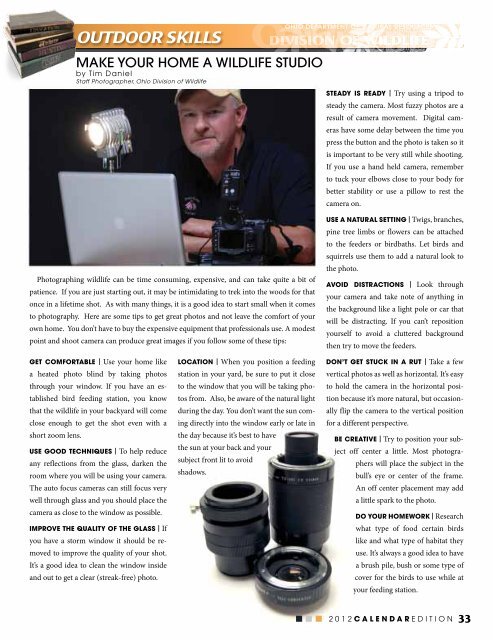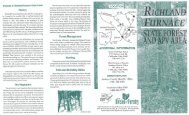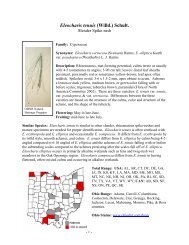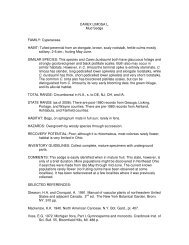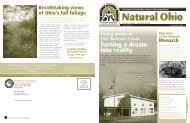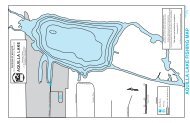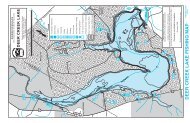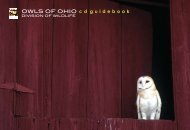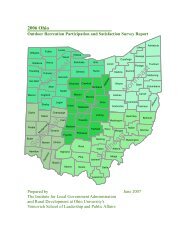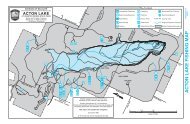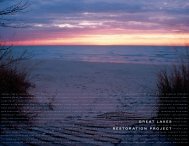2012 WILDLIFE CALENDAR - Ohio Department of Natural Resources
2012 WILDLIFE CALENDAR - Ohio Department of Natural Resources
2012 WILDLIFE CALENDAR - Ohio Department of Natural Resources
You also want an ePaper? Increase the reach of your titles
YUMPU automatically turns print PDFs into web optimized ePapers that Google loves.
outDOOR SKILLS<br />
Make Your Home a Wildlife Studio<br />
by Tim Daniel<br />
Staff Photographer, <strong>Ohio</strong> Division <strong>of</strong> Wildlife<br />
OHIO DEPARTMENT OF NATURAL RESOURCES<br />
<strong>WILDLIFE</strong><br />
Steady is ready i Try using a tripod to<br />
steady the camera. Most fuzzy photos are a<br />
result <strong>of</strong> camera movement. Digital cameras<br />
have some delay between the time you<br />
press the button and the photo is taken so it<br />
is important to be very still while shooting.<br />
If you use a hand held camera, remember<br />
to tuck your elbows close to your body for<br />
better stability or use a pillow to rest the<br />
camera on.<br />
Photographing wildlife can be time consuming, expensive, and can take quite a bit <strong>of</strong><br />
patience. If you are just starting out, it may be intimidating to trek into the woods for that<br />
once in a lifetime shot. As with many things, it is a good idea to start small when it comes<br />
to photography. Here are some tips to get great photos and not leave the comfort <strong>of</strong> your<br />
own home. You don’t have to buy the expensive equipment that pr<strong>of</strong>essionals use. A modest<br />
point and shoot camera can produce great images if you follow some <strong>of</strong> these tips:<br />
Use a natural setting i Twigs, branches,<br />
pine tree limbs or flowers can be attached<br />
to the feeders or birdbaths. Let birds and<br />
squirrels use them to add a natural look to<br />
the photo.<br />
Avoid distractions i Look through<br />
your camera and take note <strong>of</strong> anything in<br />
the background like a light pole or car that<br />
will be distracting. If you can’t reposition<br />
yourself to avoid a cluttered background<br />
then try to move the feeders.<br />
Get comfortable i Use your home like<br />
a heated photo blind by taking photos<br />
through your window. If you have an established<br />
bird feeding station, you know<br />
that the wildlife in your backyard will come<br />
close enough to get the shot even with a<br />
short zoom lens.<br />
Use good techniques i To help reduce<br />
any reflections from the glass, darken the<br />
room where you will be using your camera.<br />
The auto focus cameras can still focus very<br />
well through glass and you should place the<br />
camera as close to the window as possible.<br />
Improve the quality <strong>of</strong> the glass i If<br />
you have a storm window it should be removed<br />
to improve the quality <strong>of</strong> your shot.<br />
It’s a good idea to clean the window inside<br />
and out to get a clear (streak-free) photo.<br />
Location i When you position a feeding<br />
station in your yard, be sure to put it close<br />
to the window that you will be taking photos<br />
from. Also, be aware <strong>of</strong> the natural light<br />
during the day. You don’t want the sun coming<br />
directly into the window early or late in<br />
the day because it’s best to have<br />
the sun at your back and your<br />
subject front lit to avoid<br />
shadows.<br />
Don’t get stuck in a rut i Take a few<br />
vertical photos as well as horizontal. It’s easy<br />
to hold the camera in the horizontal position<br />
because it’s more natural, but occasionally<br />
flip the camera to the vertical position<br />
for a different perspective.<br />
Be creative i Try to position your subject<br />
<strong>of</strong>f center a little. Most photographers<br />
will place the subject in the<br />
bull’s eye or center <strong>of</strong> the frame.<br />
An <strong>of</strong>f center placement may add<br />
a little spark to the photo.<br />
Do your homework i Research<br />
what type <strong>of</strong> food certain birds<br />
like and what type <strong>of</strong> habitat they<br />
use. It’s always a good idea to have<br />
a brush pile, bush or some type <strong>of</strong><br />
cover for the birds to use while at<br />
your feeding station.<br />
2 0 1 2 C A L E N D A R E D I T I O N<br />
33


